Diversity and Equity
“It's Okay That You Add Your Touch”: Fostering Imagining and Creating Through STEAM Education
Connected Science Learning September–October 2022 (Volume 4, Issue 5)
By Megan McKinley-Hicks, Ariella F. Suchow, Kadahj A. Bennett, Lyndsay Allyn Cox, Genelle Faulkner, Meghan Hill, Michael Barnett, and Helen Zhang
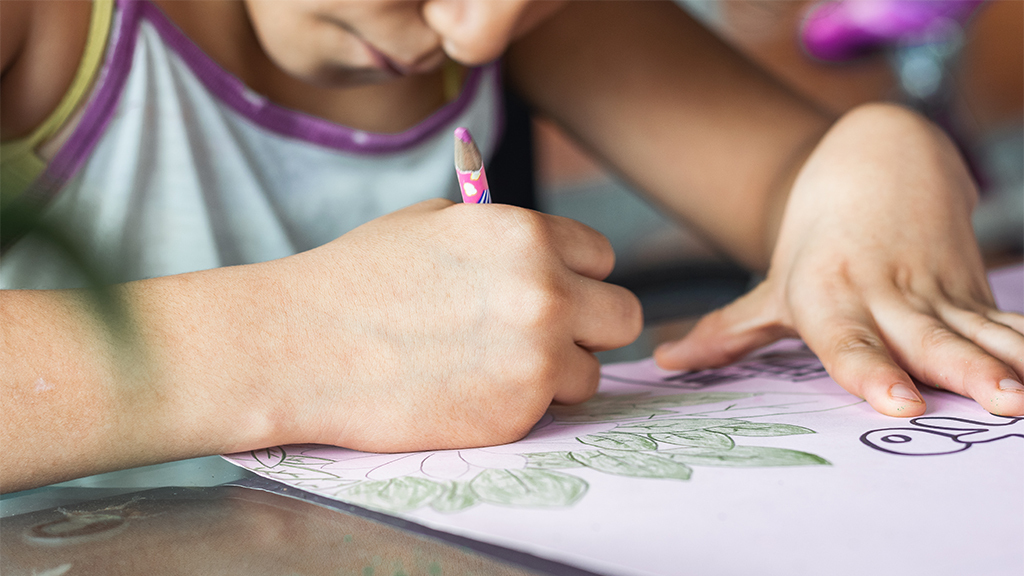
Practitioners and scholars have begun to recognize the need to fragment disciplinary boundaries in K–12 learning settings in favor of more holistic approaches (Bush et al. 2020; Kang 2019; Mejias et al. 2021; Takeuchi et al. 2020). Drawing on practices and perspectives from multiple disciplines can support learning in addition to expanding which practices and identities are valued in a given space (Finch, Moreno, and Shapiro 2020; Takeuchi et al. 2020). STEAM (science, technology, engineering, arts, and mathematics) education has been proposed as a means to reimagine science education based on youths’ widespread interest in art, design, and making, and the multiple modes of expression in these activities (Carsten Conner et al. 2017; Quigley, Herro, and Jamil 2017).
Building on the work of STEAM education scholars who foreground common practices across artistic and scientific disciplines (e.g., Bevan et al. 2019; Mejias et al. 2021), we document the design, implementation, and outcomes of Converge Art-Science (hereinafter referred to as Converge), an out-of-school art-science program for students in seventh through ninth grade. To illustrate the program implementation, we share a vignette of a group’s development and production of a play about climate change. During this project, youth conceptualized the characters and script, designed and created costumes, coded LED light accessories for the costumes, and cast and directed staff members to perform the play. We used a multiple case study approach (Yin 2018), drawing on qualitative data sources, to interpret participants’ perspectives on art-science thinking practices—or practices common to artistic and scientific fields—before and after their participation in the program. This approach supported a close examination of case study participants’ perspectives, specifically how and why their perspectives shifted after participating in the program, if at all. Our results demonstrate how STEAM education can support youth to appreciate imagining and creating in the context of science. We conclude with the program’s successes and challenges and corresponding implications for in- and out-of-school practitioners and program designers.
Program Background
In what follows, the theoretical background for the program and the program context are discussed.
Relationships between artistic and scientific disciplines
Converge was created by a multidisciplinary researcher-practitioner partnership consisting of science education researchers and science and performing arts teachers. When designing the program, we aimed to promote youths’ engagement in and reflection on practices common to artistic and scientific fields. With this goal in mind, our project team brainstormed art-science thinking practices and discussed how these practices related to those included in the national education standards, including the Next Generation Science Standards (NGSS) and the National Core Arts Standards (NCAS). Based on these ongoing discussions, we created a preliminary list of conjectured art-science thinking practices, which lie at the convergence of performing arts processes and STEM practices. This preliminary list was revised based on which practices youth reported to enact during their projects in Converge, resulting in the list depicted in the middle of Figure 1. Among the art-science thinking practices that youth reported to enact, their perspectives on the value of imagining and creating in the context of science shifted most profoundly. In response to this theme, the following section draws on literature that describes how STEAM education can support these practices.
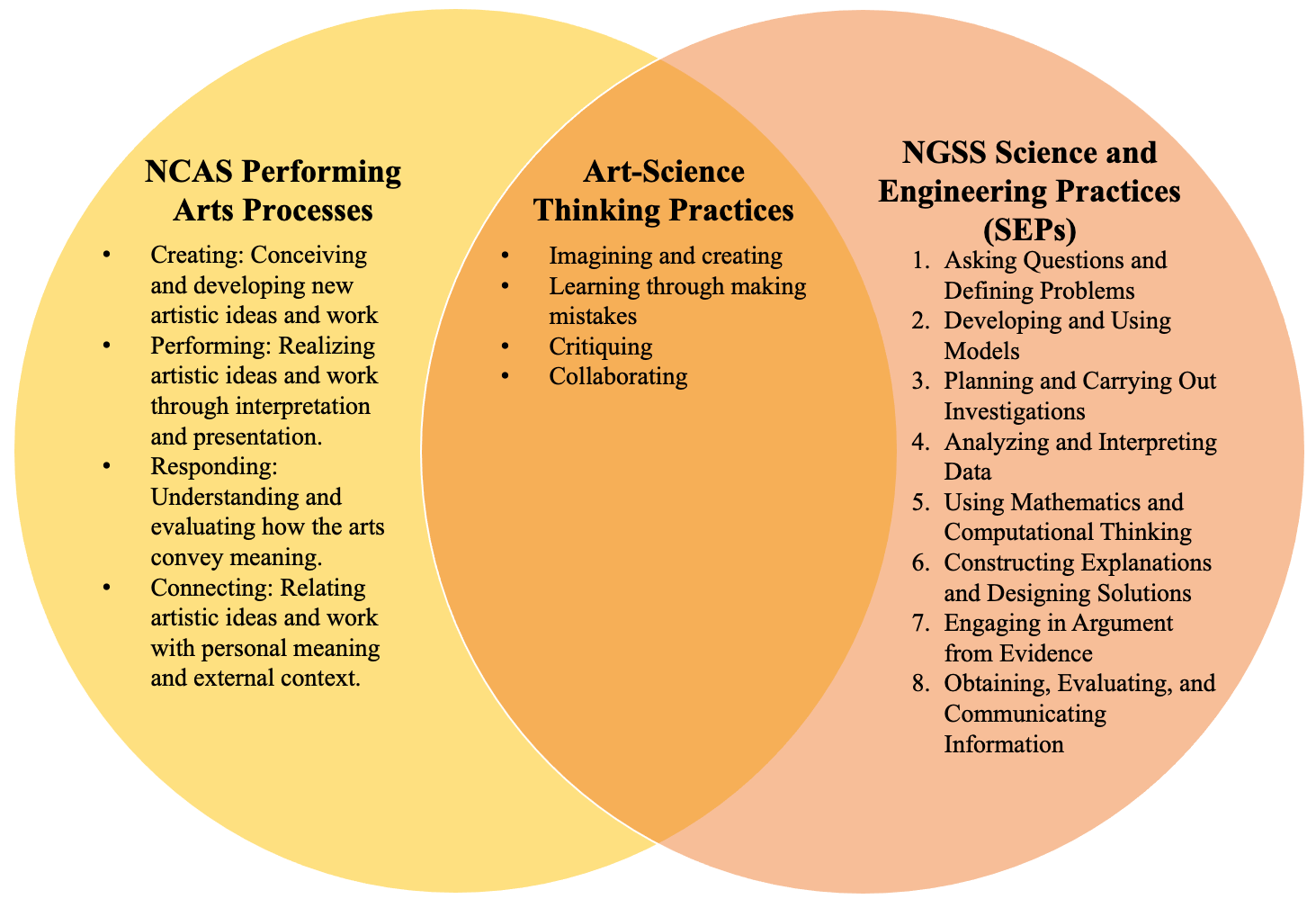
Click here for larger image
Imagining and Creating
STEAM education offers promising approaches to foster imagining and creating, practices that are often overlooked in traditional STEM learning settings (Hadzigeorgiou 2016; Kafai, Fields, and Searle 2014; Shanahan and Nieswandt 2009). The following design aspects of STEAM education can promote youths’ engagement in imagining and creating, including (1) the exploration of an open-ended challenge with multiple outcomes; (2) the incorporation of multiple disciplinary practices and perspectives; and (3) the encouragement of personal expression. The open-ended nature of STEAM education projects privileges imagining and creating over pursuing pre-determined answers or solutions (Carsten Conner et al. 2019; Keane and Keane 2016; Quigley et al. 2020). By foregrounding a challenge with multiple outcomes, STEAM practitioners can encourage learners to explore and enact different approaches to generate a solution or artifact (Kim and Chae 2016). Encouraging youth to use multiple disciplinary practices and perspectives to address an open-ended challenge is especially important (Mejias et al. 2021; Quigley and Herro 2016). The commingling of disciplines expands possibilities for youth to understand and address the challenge of interest in ways that could not necessarily be done in discipline-based learning environments (Bevan et al. 2019; Finch et al. 2020; Mejias et al. 2021).
Additionally, learners can engage in imaginative and creative thinking practices through projects that encourage personal expression (Kafai et al. 2014; Shanahan and Nieswandt 2009). The personalization of a project to a learner’s own purposes or identities differentiates STEAM projects from making a model or prototype in traditional STEM education (Kafai et al. 2014; Carsten Conner et al. 2017). For example, engineering and technology fields prioritize functionality while neglecting aesthetics and personalization, values that play fundamental roles in artistic fields (Kafai et al. 2014). Engaging in personal expression through STEAM education can foster youths’ sense of ownership for their learning and identification with STEAM disciplines (Bequette and Bequette 2012; Bush et al. 2020; Carsten Conner et al. 2017; Shanahan and Nieswandt 2009).
Program context
Our project team designed an art-science program that leveraged performing arts, STEM, and computing to engage participants in collectively developing messages about local social and environmental justice issues (Figure 2). (For a project overview, please see our video in 2020 National Science Foundation STEM for All Video Showcase.) In addition to this overarching framework, we iteratively developed principles to guide our program design and enactment. These design principles were revised over three program iterations (140.5 hours total), resulting in the principles summarized in Table 1. Each program iteration hosted approximately 15 to 25 youth in seventh through ninth grade from an urban public school district in the Northeastern United States. These students predominantly identified as Hispanic (50%) or Dominican American (22%) and bilingual (83%). During the summer program examined in this study, a total of 18 students attended program sessions on Mondays through Thursdays for four to five hours per day over three consecutive weeks (52 hours total).
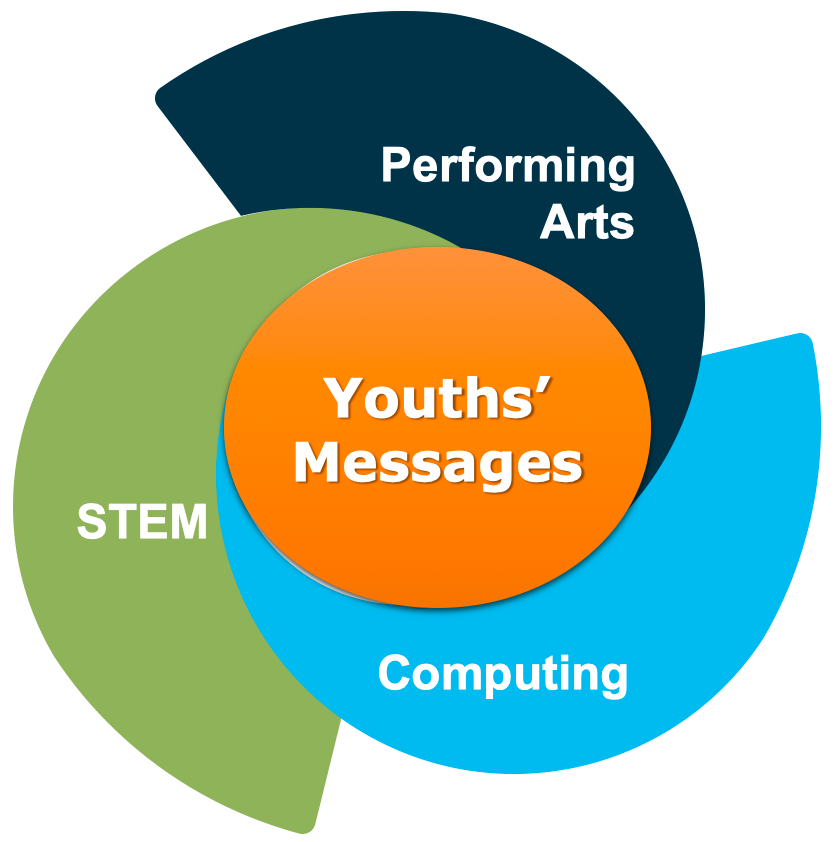
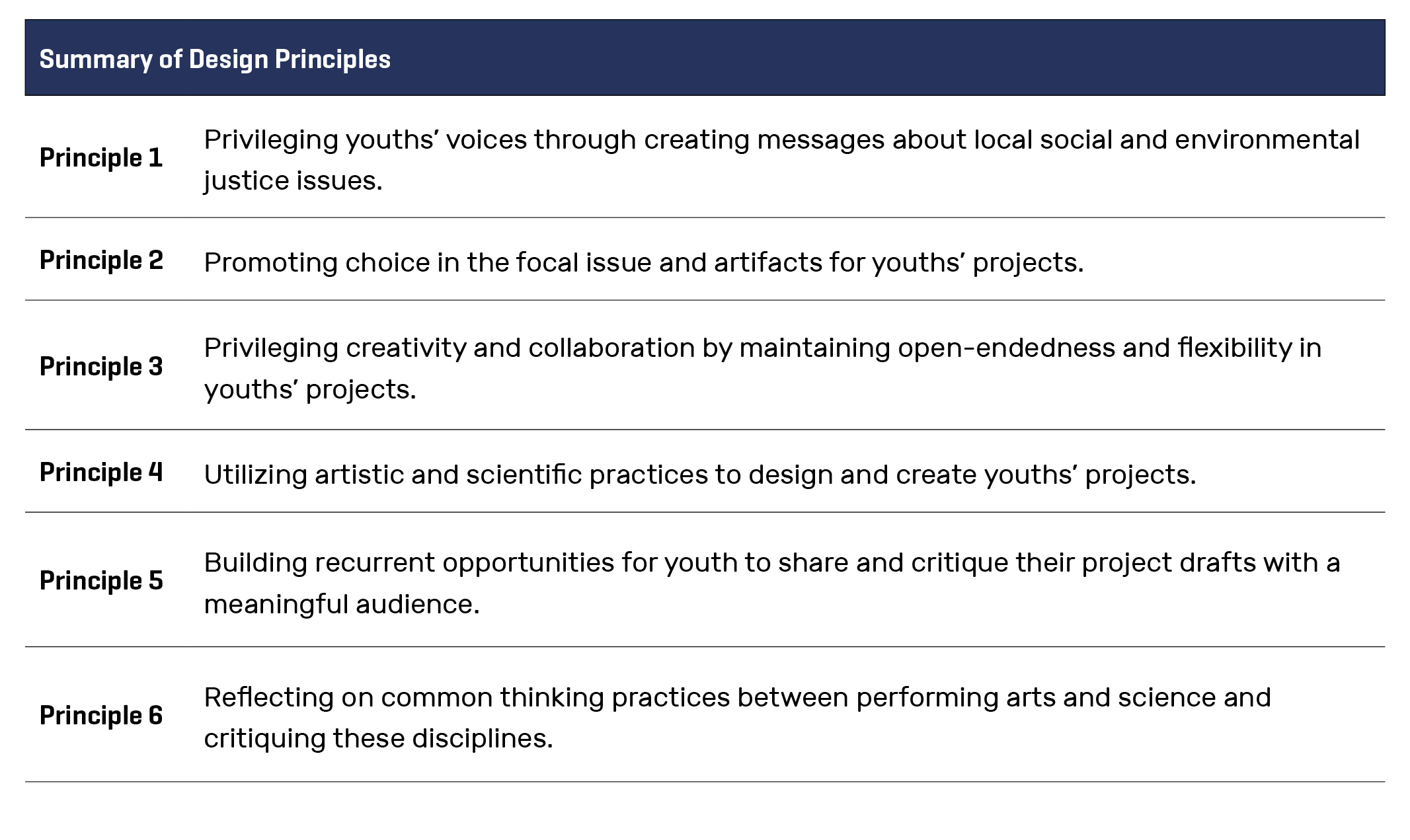
Click here for larger image
The following question guided youths’ projects during the program iteration highlighted in this study: What would you like your community to be like in 10 years? With this question in mind, groups of youth selected a local social and environmental justice issue (e.g., housing rights, food rights) to highlight in their project. Youths’ projects were presented to their family, peers, and instructors during a symposium event on the last day of the program. A summary of the weekly learning activities and the corresponding design principles are included in Table 2. (For a detailed description of daily learning activities, see Appendix A in Supplementary Resources.) It is important to note that no two groups engaged in the same processes due to the open-ended nature of the projects, specifically the embedded choices in the project format (e.g., animation, cartoon, skit) and artifacts to create for their projects (e.g., 3-D printed model, LED light accessories, script). For the program iteration highlighted in this study, youths’ projects included a cartoon about local food rights, a model of the greenhouse effect, an app vision board, a documentary about the local effects of gentrification, and a play about the local effects of climate change. (See Appendix B in Supplementary Resources for images of youths’ projects.) By encouraging participants to choose their project format and artifacts, the program structure was differentiated based on youths’ interests and identities.
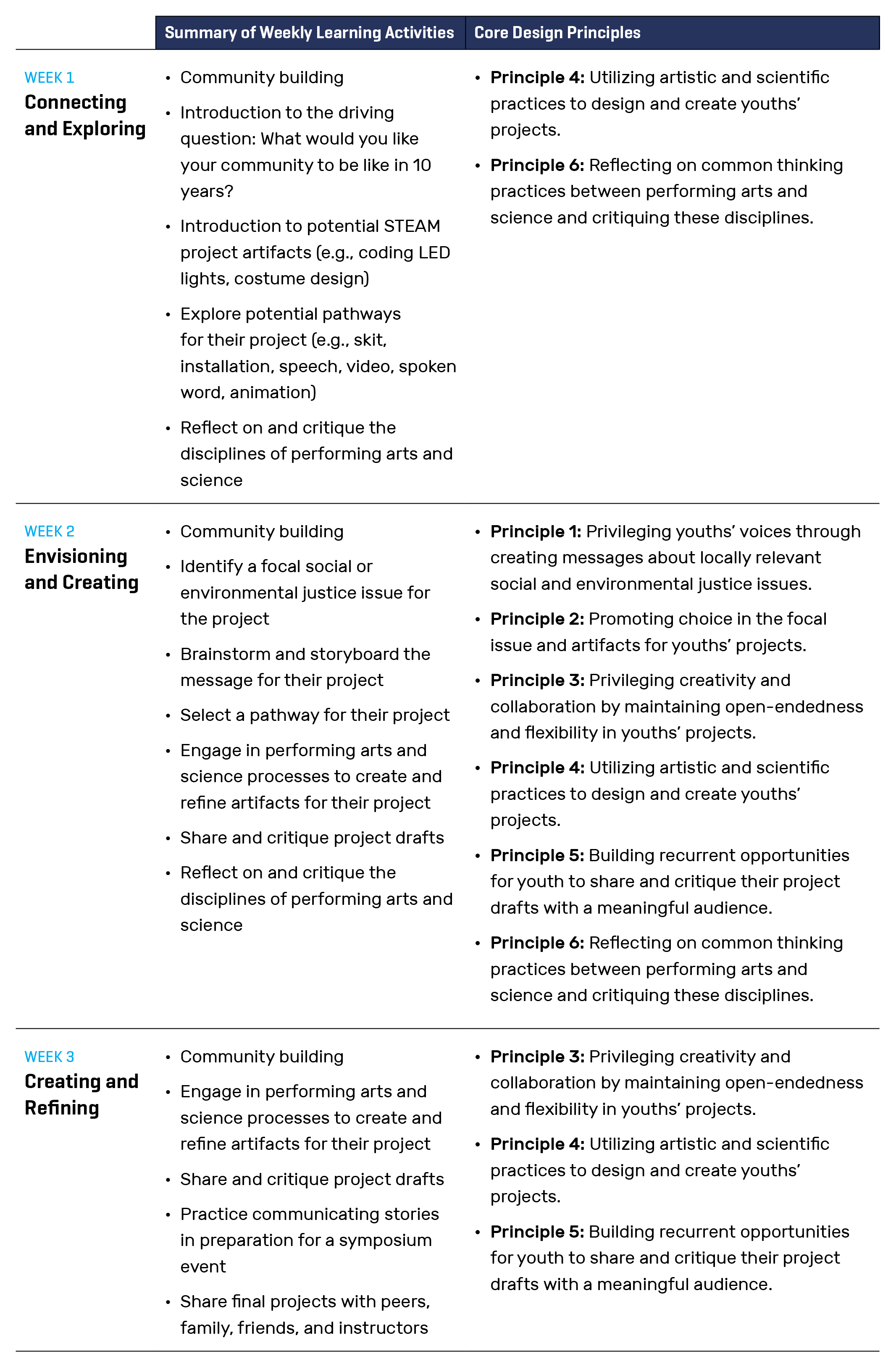
Click here for larger image
Implementation Example
Before discussing our findings, we share a vignette of a group’s creation and production of a play about climate change. We selected this example due to the multidisciplinary nature of the group’s project, which foregrounded performing arts and computing. For their project, a group of five students developed and directed a play featuring a “squad” of five middle school–age female characters who travel to the future and witness the effects of climate change on their local community. Youth conceptualized the characters and script for their play, designed and created costumes (Figure 3), coded LED light accessories for the costumes, and cast and directed staff members to play the roles of the characters (Figure 4). Among these processes, the youth were most interested in costume design and construction and coding LED light accessories for the costumes, which they worked on for the majority of their project time. To develop their costumes, the group of five divided into two specialized groups, with one group working on costume design and construction, and the other coding LED light accessories for the costumes. More specifically, the first group sketched two sets of costumes for each character—which were worn at different times during the play—before constructing the costumes using materials they requested. Based on the costume sketches, the second group used Python programming to code LED light strips to turn different colors by using an on/off switch the actors could push during the play.
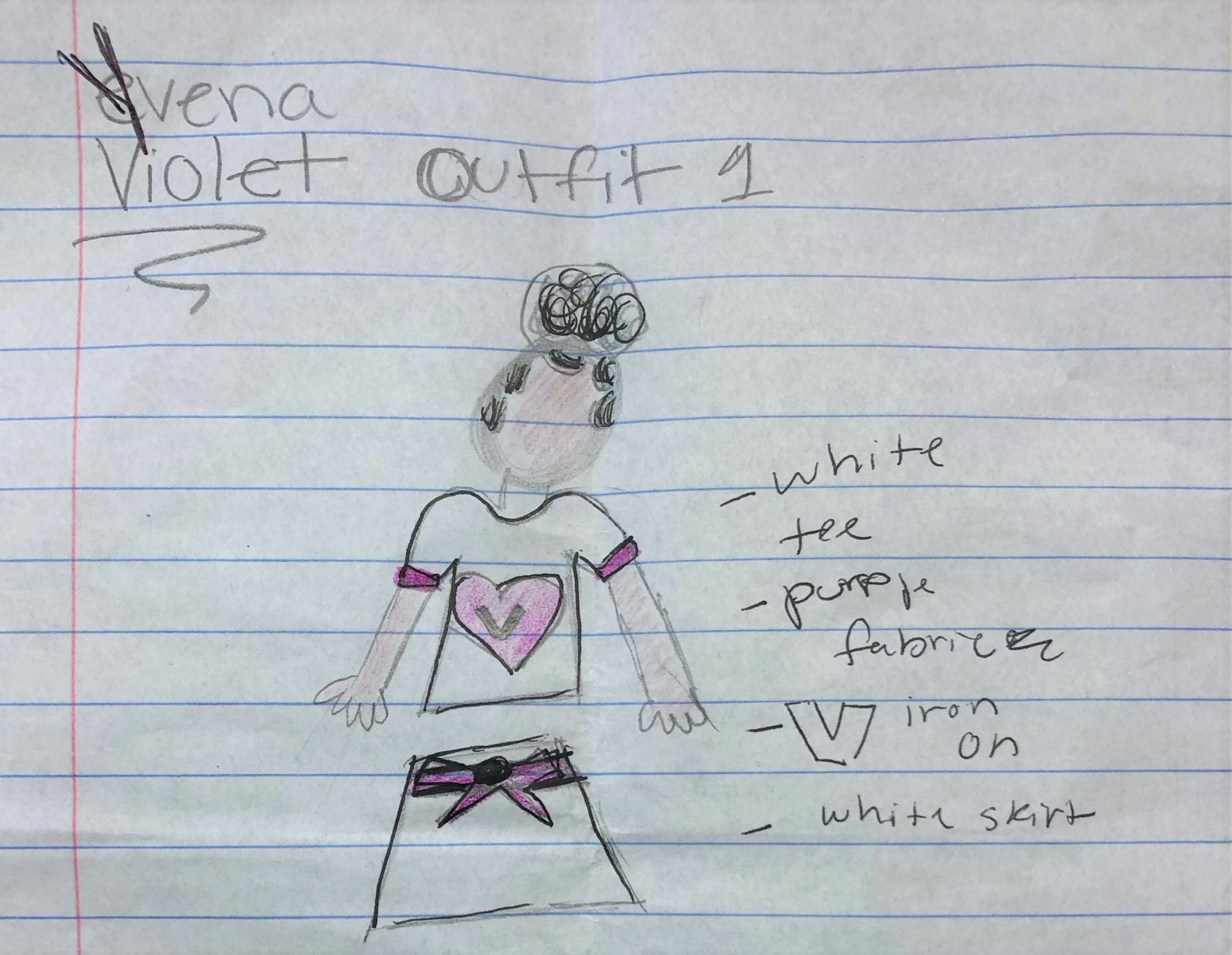
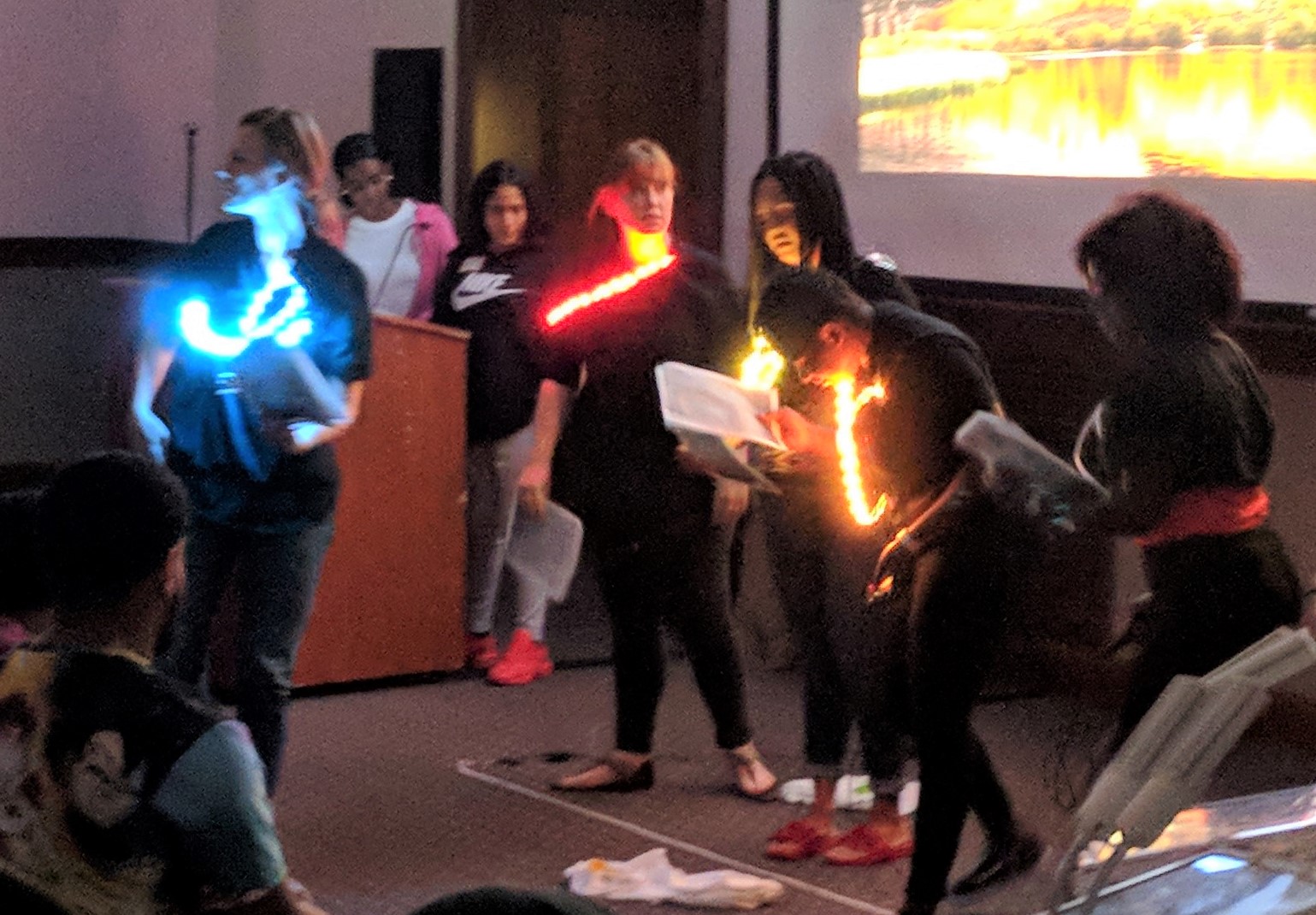
Program Evaluation
Our evaluation of youths’ experiences in Converge was informed by our framework on art-science thinking practices. One of the primary goals of the program was to engage students in reflecting on the value of art-science thinking practices in the contexts of science, performing arts, and youths’ personal lives. As a result of this reflection, we conjectured that youth would view STEM and arts processes as similar and, in turn, develop expansive perceptions of science. The following research question guided this inquiry: How do youths’ perspectives on art-science thinking practices shift after participating in an out-of-school art-science program, if at all? To assess this goal, we leveraged a multiple case study approach (Yin 2018) using qualitative methods to generate contextualized understandings of the experiences of a focal group of participants. Primary data sources included two rounds of artifact-based interviews with each youth and the artifacts generated during these interviews. Field notes and youths’ project drafts (e.g., scripts, models, costume designs) served as secondary data to corroborate findings.
Case studies were developed for four consenting youth: Elena, Lara, Jayda, and Lucas (pseudonyms). Lara, Jayda, and Lucas were part of the climate change play group discussed in the vignette above. Elena worked with a partner to generate a dynamic greenhouse model for their project, which primarily relied on science and computing. These students’ consistent attendance allowed us to develop robust data sets for each youth. These youth identified as bilingual Spanish- and English-speakers (100%), Hispanic (50%) or Dominican American (50%), and cisgender (75% female, 25% male). Case study participants were demographically comparable to the remaining youth participating in Converge, who predominantly identified as Hispanic (50%) or Dominican (22%) and bilingual (83%). (See Table 3 for a summary of program participants’ demographic information.)
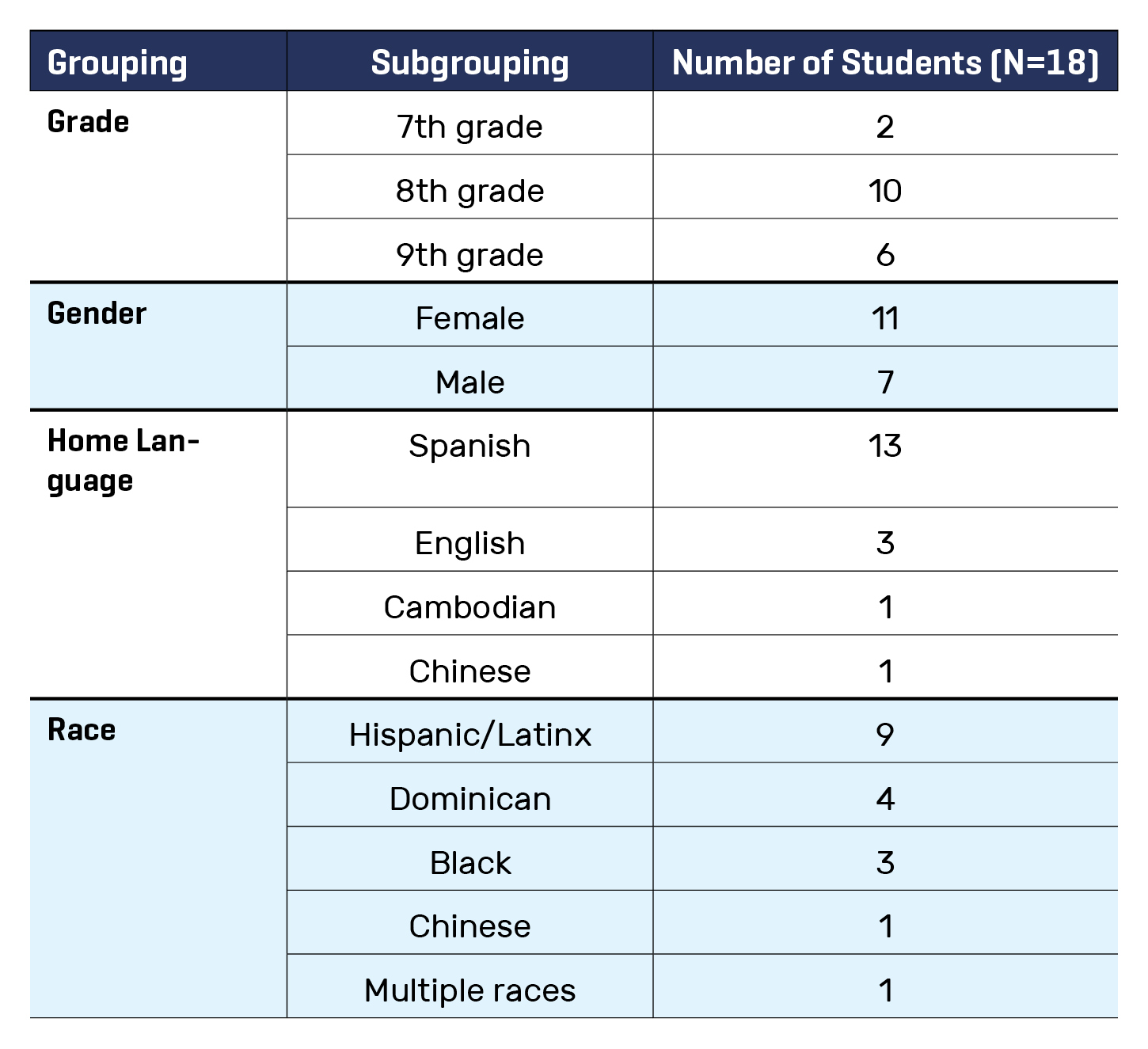
Two rounds of artifact-based, semi-structured interviews, lasting 20 to 40 minutes each, were completed individually with each case study participant before and after the summer program. When developing the interview protocols, graphic elicitation (Bagnoli 2009), specifically in the form of a relational map, was used to understand youths’ perspectives of art-science thinking practices. During the pre-interviews, participants created three relational maps to document the importance of art-science thinking practices in their personal lives and in the disciplines of science and performing arts (Figure 5). These initial maps were then revisited by youth during post-interviews, with the option of revising their maps as needed. When creating each map, participants placed cards—each with one art-science thinking practice—on the map according to how important they thought these practices were to the domain. In other words, the more critical the students considered the thinking practice to be, the closer to the center they placed the card. For each map, youth explained why they placed each card in the given location on the map, starting with the center circle and moving outward. During the post-interviews youth revisited their initial maps and adjusted them as needed. When each map was revisited, the participant was asked if he or she wanted to move, add, or remove any cards on the map before explaining his or her decisions. In addition to the relational map questions, post-interviews included questions on each youth’s project, including the youth’s role in the project and which art-science thinking practices the group members enacted and how. Finally, youth were asked about their feelings toward performing arts and science at the end of each interview.

A cross-case analysis was conducted to examine how youths’ perspectives of the enacted art-science thinking practices (Figure 1) shifted after participating in the Converge program, if at all. Data analysis revealed one theme, namely that youths’ perspectives on the value of imagining and creating in the context of science shifted to become more important.
Findings
During the post-interviews, three out of four interview participants moved “imagining and creating” closer to the center of their maps (Figure 6) because they came to view these practices as more important to science. The fourth participant, Lucas—who initially placed all four art-science thinking practices in the middle of his map—noted that he did not need to make any changes to his map, suggesting that his previous ideas about art-science thinking practices had been reinforced by his participation in the program. In what follows, we describe students’ initial views of imagining and creating before discussing shifts in their perspectives on these practices after participating in Converge.
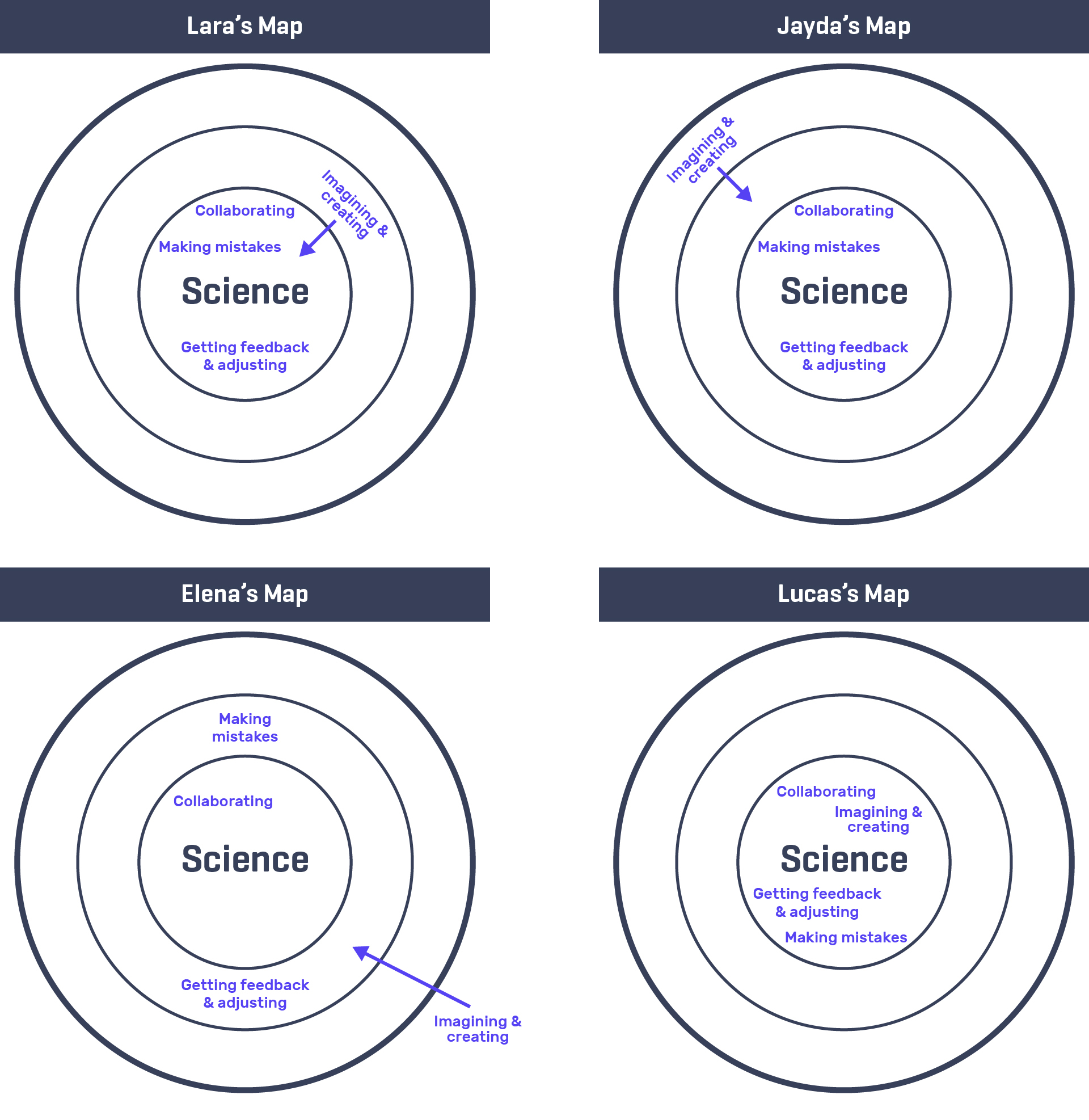
Click here for larger image
Initial Perceptions of Imagining and Creating
Three out of four participants—Elena, Jayda, and Lara—viewed imagining and creating as abstract practices that were less important than concrete practices in science. For example, Elena stated, “You need to be creative in order to think about problems and find a solution. But I don’t know how physical it can get. It’s more mental." She elaborated that creating visual models was a creative scientific endeavor but that more “physical” practices such as “creating a procedure” to conduct or getting an “end result” were more important in science. Jayda and Lara also viewed concrete practices as more central to scientific endeavors. Unlike Elena, however, both Jayda and Lara rejected the notion that these practices were valuable in science. Jayda, for example, stated, “[Y]ou don’t imagine in science, you do in science.” Jayda implied that science is a discipline that relies on concrete practices (“doing”), rather than abstract practices like imagining. Similarly, Lara explained that imagining and creating were irrelevant to science:
[Y]ou're not gonna—I mean you could create a project but you're not going to imagine. Why [are] you gonna imagine. If you have a solution to a problem, you're not going to keep imagining it. You’re gonna want to make something, prove some point, or whatever. How [are] you gonna be creative.
Lara’s utterances allude to the role of creativity and imagination in science. She stated that “if you have a solution to a problem, you’re not going to keep imagining it,” implying that one must initially imagine a solution. At the same time, however, Lara explicitly rejected the notion that science involves imagining and creating, and implicitly associated science with more concrete processes (i.e., “make something, prove some point”). The fourth student, Lucas, was the only participant who considered these practices as central to science, stating that imagining and creating were important for inventing and trying out new things in science.
Newfound Appreciations for Imagining and Creating in Science
After participating in Converge, Elena, Jayda, and Lara expressed greater appreciations for the role of imagining and creating in science. Elena attributed her new perspective to her experience developing a dynamic model of the greenhouse effect. She explained, “If you don’t have creativity, it’s really hard to create a model. In science, you use models a lot so you can help people understand what you’re doing or to share your data.” In addition to developing models (SEP 2), Elena elaborated that imagining and creating were important to “figure out a question” (SEP 1), “figure out a procedure” for an experiment (SEP 3), and “solve a problem” (SEP 6)—practices that are recognized in the NGSS.
Jayda and Lara attributed their new appreciations for imagining and creating in science to their experience developing their play project. For Jayda, engaging in personal expression to create her project fostered her new perspective. Jayda explained that imagining and creating were important in science “[b]ecause when you're trying to make stuff in science, it's okay that you add, you know, your touch. It doesn't have to be plain.” In this statement, Jayda implicitly linked imagining and creating with personal expression (i.e., “add your touch”). Further, she explicitly noted the value of personal expression when describing Converge: “It's a way to express yourself. So, if you wanted to express yourself, you should probably do that. Because in performing arts you express yourself and, I guess, in science as well but mostly in performing arts.” In this statement, Jayda grapples with whether or not personal expression is permissible in science and, in the end, associates this practice more with performing arts.
Meanwhile, Lara connected her newfound appreciation for imagining and creating to multiple factors, including her group’s personalization of their project, collaboration among group members, and incorporation of multiple disciplines. Lara explained that imagining and creating were important in science “because you don't want to do the same stuff as anybody else did. Then you wouldn't be your own person.” Lara recognized the value of imagining and creating in science regarding doing work that is personalized to the people who are creating it, similar to Jayda’s rationale (“it’s okay to add your touch”). Interestingly, Lara equated collaborating with imagining and creating, stating that they were the “same thing.” She linked these practices again later in the interview, stating that “With more people involved in the group [project], we could have more ideas on what to do.” In other words, Lara recognized that collaborating with multiple people encouraged her group members to engage in imagining and creating when developing their project. Lastly, Lara also recognized that incorporating multiple disciplines fostered her group’s creativity. When reflecting on her group’s play project, she stated: “I felt like we were more creative. And we actually included science, performing arts, and coding. Not just one topic.” Here she contrasted her group’s experience incorporating multiple STEAM disciplines with her experience in previous disciplinary projects, suggesting that her group’s multidisciplinary project was more creative.
Discussion
Case study participants’ utterances highlight how engaging in a STEAM project fostered new perspectives on imagining and creating in the context of science. For example, Elena’s case specifically demonstrates how creating a 3D representation or model created opportunities for her to recognize the value of imagining and creating in science. Because engaging in imaginative and creative thinking to develop representations is an endeavor common to scientific and artistic fields (Bevan et al. 2019; Mejias et al. 2021), engaging youth in creating representations could be a fruitful area for future STEAM program development and research. At a more general level, several STEAM project features supported Lara’s and Jayda’s shifting perspectives on imagining and creating, including the use of multiple disciplines, peer collaboration, and personal expression. These findings are consistent with previous scholarship in STEAM education (e.g., Carsten Conner et al. 2017; Kafai et al. 2014; Quigley et al. 2017; Shanahan and Nieswandt 2009). Lara’s utterances highlight how the commingling of STEAM disciplines and collaboration among individuals engaged in these disciplines can fuel imaginative thinking (Bevan et al. 2019; Mejias et al. 2021). According to Lara, her group was “more creative” because they incorporated multiple disciplines and ideas from multiple people (“more people” leads to “more ideas”). In other words, an open-ended project that relied on multiple disciplines expanded possibilities for the group project in terms of what type of project and artifacts they developed and how (Carsten Conner et al. 2019; Keane and Keane 2016; Quigley et al. 2017, 2020). Both Lara and Jayda recognized that creating a STEAM project that was personalized by the group members supported their newfound appreciations for imagining and creating in science. Although Jayda came to recognize that it was “okay” to add “your touch” in science, she still mainly associated personal expression with performing arts rather than science. This perspective is perhaps unsurprising given that imagination and creativity often are neglected in traditional science curricula (Hadzigeorgiou 2016; Kafai et al. 2014; Shanahan and Nieswandt 2009).
Recommendations for practitioners
Although participating in Converge encouraged youth to develop more expansive perspectives of science—specifically regarding the value of imagining and creating—their participation in this program reaffirmed and solidified, rather than transformed, their pre-existing interests with certain disciplines. In other words, because youth were able to engage in disciplinary processes with which they were interested, their interests were reaffirmed along disciplinary lines. For example, Jayda, who reported that she “didn’t get” coding, withdrew from computing experiences that were outside of her comfort zone. Instead, she gravitated toward activities with which she had prior experience and interest (e.g., fashion design). Similarly, Lara, Lucas, and Elena, who were more interested in STEM subjects rather than performing arts, had the freedom to primarily participate in STEM processes, while avoiding artistic processes. As a result, Jayda became more interested in fashion design and Lara, Lucas, and Elena became more interested in STEM after participating in the program.
On the one hand, the open-ended nature of the projects—which maintained space for youth to build on their interests, experiences, and skillsets—was a strength of the program. Yet, this strength was also a weakness because it did not encourage youth to pursue pathways outside of their comfort zones. To support youth in exploring novel endeavors, we recommend devoting extensive time for youth to practice activities with which they have limited experience (e.g., computing) before beginning their projects. Another approach would be to embed artistic and scientific activities within one another through interdisciplinary or transdisciplinary approaches so that youth would need to enact multiple disciplinary practices and perspectives simultaneously (Bevan et al. 2019; Mejia et al. 2021; Quigley et al. 2016). Kafai and colleagues (2014), for example, leveraged a similar approach during an e-textile project in which youth concurrently engaged in crafting and coding through the use of LilyPad Arduino kits.
Conclusion
Case study participants’ data highlight how youths’ views of the value of imagining and creating shifted after participating in an out-of-school art-science program. Our findings suggest that STEAM education can support learners to think about ideas and practices that cross and extend beyond disciplines, particularly for the roles that imagination and creativity play in STEM fields. This represents a promising area for further research, namely how STEAM education influences youths’ views of the roles of imagining and creating. With our findings in mind, it is important to recognize that case study youths’ experiences and perspectives were influenced by the program context. Converge’s out-of-school learning setting allow for substantial flexibility for youths’ STEAM projects, in terms of the project topic, format, and artifacts. Although Converge was an out-of-school program, we believe that aspects of our program design, particularly the conceptualization of art-science thinking practices, have much potential for use in K–12 settings through partnerships between science and arts educators. Encouraging imaginative and creative thinking, and recognizing these practices as valuable in scientific fields can support youth, like Jayda, whose creative identities might otherwise go unnoticed in traditional STEM learning spaces. Our future research will further investigate how various approaches to discipline integration (e.g., multidisciplinary, interdisciplinary, transdisciplinary) influence youths’ engagement in and reflections on art-science thinking practices.
Megan McKinley-Hicks is a curriculum developer, Michael Barnett is a professor of STEM education, and Helen Zhang is a learning scientist, all at Boston College in Chestnut Hill, Massachusetts. Ariella F. Suchow is the Director of Academic Program Strategy and Coordination at Explore Schools in New York City. Kadahj A. Bennett is a songwriting and performance manager at Zumix in Boston, Massachusetts. Lyndsay Allyn Cox is an operations manager at Actors’ Shakespeare Project in Boston, Massachusetts. Genelle Faulkner is a science teacher at Youth Achiever Pilot School in Boston, Massachusetts. Meghan Hill is a producing artistic director at Brooks School in Andover, Massachusetts.
citation: McKinley-Hicks, M., A.F. Suchow, K.A. Bennett, L. Allyn Cox, G. Faulkner, M. Hill, M. Barnett, and H. Zhang. 2022. “It's okay that you add your touch”: Fostering imagining and creating through STEAM education. Connected Science Learning 4 (5). https://www.nsta.org/connected-science-learning/connected-science-learning-september-october-2022/its-okay-you-add-your
Equity Interdisciplinary NGSS Science and Engineering Practices Middle School Informal Education


